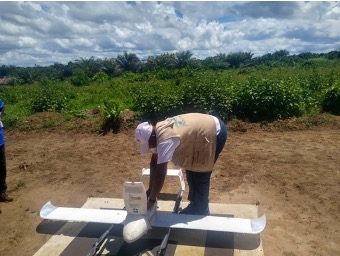
DRONELIFE is honored to feature this guest post by Olivier Defawe, Director Health Systems at VillageReach, and founder of the UAV for payload delivery working group (UPDWG) focused on the advancement and application of drones for public health and supply chain improvement. DRONELIFE neither accepts nor makes payment for guest posts.

Using a drone delivery network, the provincial health authorities have been distributing both routine and on-demand vaccines and other immunization products monthly for children and women in 35 hard-to-reach health areas, via 20 drone landing sites. Because the drones can land almost anywhere, the drones return with a broad range of products, including yellow fever and COVID-19 laboratory samples.
Other deliveries have included medical reports, and at times on-demand deliveries of personal protective equipment (PPE) in support of the COVID-19 response, as well as vaccines, medicines and contraceptives. Now the results are in and the delivery network is delivering successful outcomes. In the last nine months, more than 15,000 children and 5,500 pregnant women who live in the most hard-to-reach locations have received immunization services because of the introduction of drones.
Given this success, it is no wonder that the provincial government is once more turning to the drone technology to help meet its objective of reaching more than three million people aged between nine months and 60 years of age during the 10-day yellow fever preventive campaign in Equateur.


Dr. Nicole Lubanda, the lead representative for yellow fever and measles from the EPI, traveled to the Bikoro health district to serve as the national supervisor for the yellow fever mass vaccination campaign.
She learned of the support that the drones had provided to the district with routine vaccine deliveries. When she reached the site, one of the drones was arriving at the district-landing site from a trip to Maanga, which is one of three health catchment areas benefiting from drone deliveries of yellow fever vaccines. It is a village only accessible through a lake and situated 100 km from the Bikoro health district office.
She was amazed to open the storage compartment of the drone that just arrived and said “[…] the drone helps us to ship both vaccines and other products as well as daily reports so that we can keep track of the [progress of the campaign]. [Within] about 10 to 20 minutes, we sent 5 to 10 frozen accumulators or vaccines and this allows us to supply hard-to-reach areas in record time.”
Trips reduced from two days to 25 minutes
“This year has been different with the support from Drones for Health. More than 9,900 doses of yellow fever vaccines and diluents would be needed in Ipombo to vaccinate the targeted population between the ages of nine months and 60 years of age,” said David Moponda. “Within a four-day period, and only 25 minutes for each trip, the drones had already delivered 4,200 doses of the vaccine.”
Operations had to be suspended since the refrigerator of the health facility was already at full capacity. However, once space is freed up, flights will take off again.
Yellow fever vaccine campaign transformation
1) The drones enabled to leapfrog the lack of functional cold chain where the campaign was being conducted. Drones allowed for just-in-time delivery of yellow fever vaccines to the campaign team as the campaign progressed in the region, eliminating the need for cold-chain equipment.
2) The drones allowed for rapid-response to unexpected needs encountered by the campaign team. This allowed on-demand resupply of products, like vaccination cards.
3) Epidemiologic surveillance activities were increased and drones allowed for quick transport of samples from health facilities to provincial-level laboratories for processing.
Overall, the drones increased the reach, effectiveness and responsiveness of the yellow fever vaccine campaign.
As the campaign nears its end, it is clear that creative solutions come from using what is already available, but in new ways – and leveraging a drone network used for routine delivery for a mass vaccine campaign has just expanded the value of drone technology for the health system in Equateur, DRC.
Read more from Olivier Defawe in an earlier DRONELIFE Op-Ed: COVID-19 is Here: Now, Where are the Drones?